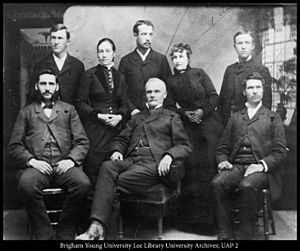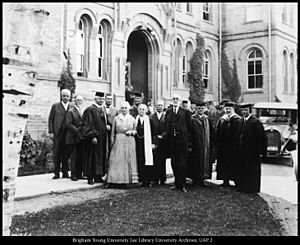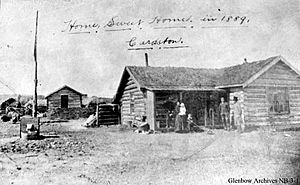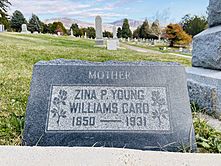Zina P. Young Card facts for kids
Quick facts for kids
Zina P. Young Card
|
|
|---|---|
 |
|
| Born | April 3, 1850 |
| Died | January 31, 1931 (aged 80) Salt Lake City, Utah
|
| Spouse(s) |
|
| Children | 5 Zina Young Card Brown |
| Parents |
|
Zina Presendia Young Williams Card (born April 3, 1850 – died January 31, 1931) was an important American leader and activist. She worked for women's rights and religious freedom. Zina was the daughter of Brigham Young, who was the second president of The Church of Jesus Christ of Latter-day Saints (LDS Church).
She was the first "Dean of Women" at Brigham Young Academy (BYA), which is now Brigham Young University. Zina fought for women's suffrage, which means women's right to vote. She also supported the practice of plural marriage, where a man could have more than one wife. Later, she moved to a new community in Cardston, Alberta, Canada. There, she became a key leader for both the community and the church. People often called her "the unquestionable female leader of the Alberta colonies."
Contents
Zina's Early Life and Family
Zina P. Young was born on April 3, 1850, in Salt Lake City, Utah Territory. Her parents were Brigham Young and Zina D. H. Young. She grew up in a large home called the Lion House. She lived there with her mother, twelve of her father's other wives, and many half-siblings. One of her half-sisters was Susa Young Gates.
Zina was part of a group called the "big ten," which included ten of Brigham Young's daughters born close together. Zina was her mother's only daughter. She remembered her childhood as very happy and had a close relationship with her mother. Education was very important in the Young family. Zina learned dance, music, and theater at home. Her upbringing was more privileged than many other pioneers.
When she was thirteen, Zina started acting at the Salt Lake Theatre. At nineteen, her father asked her to become the secretary of the Retrenchment Association. This group helped women learn important skills.
Zina's Marriages
At the Salt Lake Theatre, Zina met her first husband, Thomas Child Williams. He was the theater's treasurer and also worked for her father. Zina was eighteen and Thomas was forty when they married on October 12, 1868. She became a plural wife.
Zina and Thomas had two sons: Sterling Williams (born 1870) and Thomas Edgar Williams (born 1873). Sadly, Thomas Williams died in 1874. Her father passed away in 1877, and her son Thomas died in 1881.
In 1884, Zina married again to Charles Ora Card, a farmer and local leader. They first met when Zina was the matron at Brigham Young Academy. Charles's daughter was a student there. Zina and her mother were later asked to move to Logan, Utah to work in the new Logan Temple.
Charles Card wrote to Zina and proposed marriage. She was surprised and didn't answer right away. She said she had a dream that convinced her he was the right person. So, Zina became a plural wife for the second time on June 17, 1884.
Six months later, Charles married another wife. Because of laws against polygamy, Zina and Charles often had to live in hiding. They sometimes stayed together and sometimes apart. They wrote letters to each other using fake names to avoid being caught. Zina got along well with Charles's other wives. When Charles decided to move to Canada, Zina was chosen by his other wives to go with him. Zina and Charles had three children together.
Throughout her life, Zina spoke positively about plural marriage. She believed it was a sacred practice. She even went to Washington, D.C. to speak against laws that would stop plural marriage. She spoke to the U.S. House Judiciary Committee and the Senate. She told Senator George F. Edmunds that plural marriage seemed "far more holy and upright and just to womankind."
When Wilford Woodruff, the LDS Church President, announced in 1890 that the church would no longer officially practice polygamy, Zina wrote that it was "a very strange pill." However, she believed it was necessary for the church at that time.
Zina's Work and Activism
After her first husband died, Zina supported herself and her sons. She taught people how to make wax flowers and even produced silk. In 1878, she decided to go to school at Brigham Young Academy (BYA). She later became the school's first Ladies' Matron. She worked hard to make sure the LDS Church supported the school.
For seven years, she was in charge of the "domestic science department." This department taught practical skills for running a home. Zina also stressed the importance of knowing about nursing and biology.
As the "Dean of Women" at BYA, Zina was asked by LDS Church President John Taylor to attend a convention in 1879. This was for the National Woman Suffrage Association, a group that wanted women to have the right to vote. Zina was one of the first women from Utah to support women's suffrage.
She and Emmeline B. Wells traveled to Washington, D.C. and other parts of the eastern United States. They spoke about women's right to vote and their religious beliefs, especially plural marriage. Zina spoke to the U.S. Senate and the House Judiciary Committee in favor of plural marriage. While in Washington, Zina met famous people like Susan B. Anthony, Elizabeth Cady Stanton, and President Rutherford B. Hayes. When Zina and Emmeline returned to Utah, they shared their experiences with people across the state.
When Zina moved to Canada, she became the "first lady" of the first Latter-day Saint community there. She often met with Canadian politicians, journalists, and business people, inviting them to her home. She was not afraid to share her opinions. Her husband, Charles, said she would sometimes give "sharp retorts" when defending her beliefs, especially about polygamy.
Zina was also involved in Cardston's businesses. She helped start a sawmill, a creamery (for dairy products), a cheese factory, and a general store. She often invested her own money in these local projects. She loved theater and started a theater and a "dramatics association" in Cardston. Zina also became a midwife, helping women in Cardston give birth. She and Charles often traveled to nearby communities to give speeches. People thought Zina was often the better speaker.
Later in her life, Zina was the matron of the LDS Business College. She believed that worldly knowledge was not enough without spiritual understanding. She also became the chairman of the Relic Committee for the Daughters of Utah Pioneers and then its president in 1909. From 1918 until her death, she served on the Board of Trustees for Brigham Young University.
LDS Church Service
Zina's first leadership role in the LDS Church was with the Young Ladies' Department of the Ladies' Cooperative Retrenchment Association. She then served as the Primary president for the Utah Stake and a counselor for the Utah Stake Young Ladies' Mutual Improvement Association (YLMIA).
In 1887, Zina moved to Canada because her husband, Charles, was asked to start a Latter-day Saint community there. She was worried about leaving her aging mother, but she traveled with a group from Cache Valley in wagons. She bought her own supplies for the trip. When they arrived in Cardston, Alberta on June 3, 1887, Zina and Charles were reunited.
Over time, Zina became known as "Cardston's First Lady." She welcomed many important visitors into her home. She continued her work in the YLMIA in Alberta, serving as its president for sixteen years. In this role, she guided the spiritual and social lives of women and girls throughout southern Alberta. They would often gather at her home to perform plays or hold educational events.
After her second husband died, Zina served on the LDS Church's Primary General Board. She also worked in the Salt Lake Temple.
Zina's Personal Life
Zina had a very close relationship with her mother throughout her life. When Zina's first husband died, her mother moved in to help her. After Zina moved to Canada, her mother visited often. Zina would also travel to Utah to visit her mother, often bringing her children. Her mother died in 1901 during one of Zina's visits.
Zina's 8-year-old son, Thomas E. Williams, died in 1881. This was followed by a broken engagement. However, she did marry again. Zina and Charles Card showed their love and respect for each other in their letters. Before escaping to Canada, Zina and Charles were often separated. Zina also had good relationships with her sister-wives. She believed plural marriage was a respectable and divinely inspired practice, and she felt it was women's duty to defend it.
Besides her sons, Sterling and Joseph, Zina gave birth to a daughter, Zina Young Card Brown, in 1888, and another son, Orson Rega Card, in 1891. When they first arrived in Alberta, the family lived in a tent during the summer. Then, they moved into a one-room log cabin. In this cabin, they welcomed important guests and held parties and events for the community. They also welcomed local native people, likely Blood Indians (Kainai Nation), into their home. Zina invited their children to the Cardston school and suggested that the settlers' children learn their language.
According to her daughter, Zina enjoyed telling stories and drawing. She balanced her public duties with being a mother. Her home was peaceful, clean, and well-organized, much like her childhood home. After Zina inherited a large sum of money from her father, she had a bigger brick home built for $6,000.
Zina and Charles Card moved back to Utah in 1903 because Charles was having health problems. He died in 1906. Zina remained financially stable and stayed in Salt Lake City. She had health issues, especially with her eyesight, after caring for patients during the Spanish flu epidemic. She also suffered from psoriasis, a skin condition, but she handled it well. While recovering, she had a near-death experience, which she shared with her family.
Zina continued to be active in church and educational leadership roles until she died on January 31, 1931, at the age of 80. She is remembered for her strong devotion to her family and her faith.
Zina Young Card Brown
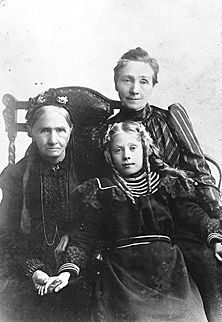
Zina Card's only daughter was Zina Young Card Brown, the fourth Zina in the family. Like her mother, Brown valued education. She studied public speaking and home economics at Brigham Young College in Logan. In 1908, she married Hugh B. Brown, who later became an LDS Apostle, in the Salt Lake Temple. They had eight children.
While Hugh was in France during World War I, Brown managed their money and survived the 1918 flu epidemic with all her children. Zina Card visited them in Canada as often as possible, and Brown often visited her mother in Salt Lake City. At age 48, Brown was asked to serve a church mission in Britain with her husband. However, they had to leave England when World War II began. When it was safe to return to London after the war, she helped arrange for clothing to be sent from the church in Salt Lake City to help church members in London who were in need.
After their time in London, Hugh and Zina Brown returned to Utah and moved to Provo. Hugh worked at Brigham Young University, where seven of their eight children attended school. In 1953, Hugh was called as an Assistant to the Twelve Apostles. Zina traveled with him around the world, visiting places like South Africa, Australia, New Zealand, Hawaii, and Fiji. She was often asked to speak at church meetings and events.
Hugh was called as an Apostle in 1958, and then as a counselor to David O. McKay in the First Presidency in 1960. After having a stroke, Zina Brown could no longer speak or move. She was in bed for eight years before she died on December 19, 1974, at age eighty-six. Many important church leaders attended her funeral. The First Presidency, including Marion G. Romney, N. Eldon Tanner, and Spencer W. Kimball, spoke highly of her life.
Zina's Legacy
Zina Young Card was a leader in education, politics, and religion throughout her life. She was the dean of two colleges and spoke up for women's right to vote and for plural marriage at a national level. In Canada, she met with political leaders and business people. In the U.S., she met President Rutherford B. Hayes and the First Lady, as well as other politicians.
Zina always supported education for everyone. She held many leadership positions in the LDS Church, traveling and speaking to different groups of people. As "Cardston's First Lady," she guided the Latter-day Saint settlers. Through her role as a church leader for young women, she guided women and girls. She worked to build good relationships with the Blood Indian Tribe, who were neighbors to Cardston.
Her other efforts included promoting the performing arts, working as a midwife, strengthening families, and helping develop local industries like farming, livestock, mills, and factories. Zina and Charles Card were honored many times by the people they led for their achievements in the community. LDS President John Taylor especially praised Zina Card for her work in Cardston. She was widowed twice and lived to be 80 years old.
The Cards' original home in Cardston, Alberta, is still standing and is now a museum. It is sometimes called "Mother Canton's Flannel Place," because Zina Card made and used flannel as wallpaper in her cabin.
By 1911, the Latter-day Saint population in Alberta reached 10,000 people. As of 2020, about 82,000 members of the LDS Church live in the region.
Her great-grandson is Orson Scott Card, the author of the famous book Ender's Game.
|


